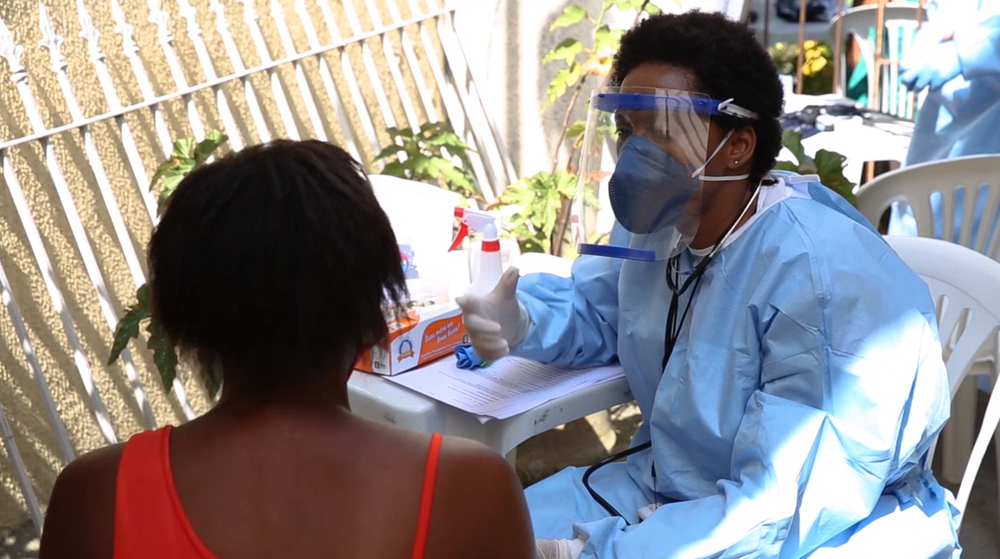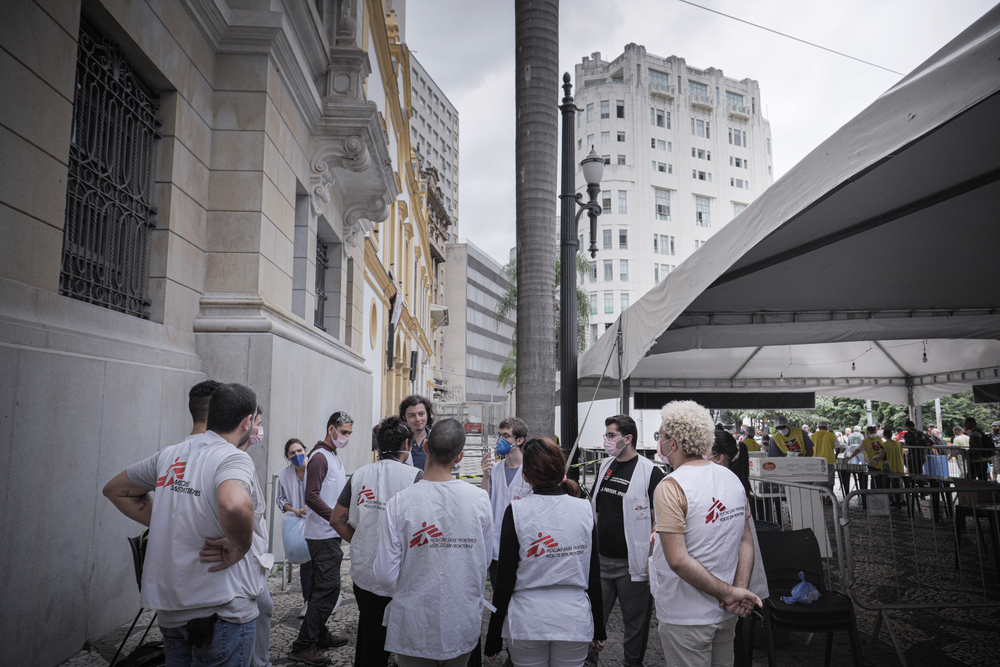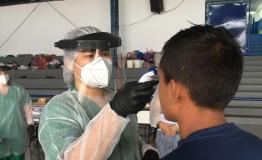In Brazil, between 15,000 and 30,000 Brazilians are infected with COVID-19 daily, and hundreds of people are dying. The country has more than 43,000 deaths and nearly 870,000 cases.
The pandemic’s waves in the country have moved from rich to poor, and from the coastal cities to the interior, threatening the most vulnerable and neglected – residents of slums and favelas, homeless people, and indigenous and riverside communities.
The capacity to respond to the needs in the country is being decimated. Nurses in Brazil are dying of COVID-19 faster than in any other country in the world, with almost 100 nurses dying from the disease per month. The number of people with suspected and confirmed cases has exploded, rising from 230 in early April to 11,000 in early May.
Testing is being rolled out at an incredibly slow pace, with Brazil reporting 7,500 tests per million people, which is almost 10 times less than the US (74,927 per million), and 12 times less than Portugal (95,680 per million). With Brazil the second most-badly hit country in the world after the US, both in terms of total cases and in total deaths, it is clear that the situation country-wide is catastrophic.
A high percentage of the patients going into intensive care units were dying; and large numbers of medical staff were falling sick.Dr Bart Janssens, MSF Emergency Coordinator in Brazil
Médecins Sans Frontières (MSF) teams have seen that vulnerable groups and neglected areas of the country, such as Amazonia, are bearing the brunt of the crisis. As a result, has launched six COVID-19 emergency responses: in Amazonas and Roraima states in the greater Amazonia region; in Rio de Janeiro; and in São Paulo. Some are now well-established, and some are in emergency start-up phase.
Very sick patients, not enough staff in Amazonas
Amazonas state, in the country’s northwest, has the highest mortality rate from COVID-19 in Brazil. In Manaus, the state capital, the situation in the hospitals has been devastating.
“The four main hospitals in Manaus were all full and the hard-working medical teams were dealing with extremely sick patients, often arriving too late and too far gone to be saved,” says Dr Bart Janssens, MSF Emergency Coordinator who launched our response. “A high percentage of the patients going into intensive care units were dying; and large numbers of medical staff were falling sick.”
The astonishing death rates were due to the sheer numbers of very sick people needing intensive care treatment with oxygen and there not being enough intensive care unit (ICU) beds or staff. For several weeks, hundreds of people were falling increasingly ill in non-ICU hospital wards, waiting for an ICU bed to become free.
In Tefe, a town one and a half days’ boat journey up the Amazon river, the medical staff were confronting an even more challenging situation.
“When I visited to assess the situation, the hospital management team were telling me that almost 100 per cent of their COVID-19 patients needing intensive care had died,” says Dr Janssens. “They did not have enough specialist staff to care for the very sick patients that were arriving at their door.”

Providing care for COVID-19 in Rio de Janeiro
High death rates are also seen in Rio de Janeiro, São Paulo and most recently in Boa Vista, a city on the northern border with Venezuela.
“It is not a coincidence that Brazil is suffering so acutely,” says Ana de Lemos, executive director of MSF Brazil. “We have long known that Brazil is a country with enormous inequalities, but COVID-19 is shining a terrible and clear spotlight, exposing a health system that is plagued with structural inequalities and exclusion from care for huge numbers of poor or homeless people, and for regions such as Amazonia that have been starved of proper health investment for decades.”
“We have seen amazing efforts deployed at state or local level to deal with the pandemic, but we also see a huge misalignment in guidelines, policies, and general approach between central government and the regions,” says de Lemos. “This sows confusion and serves to weaken the national response – with government statements on occasion treating the thousands of COVID-19 deaths as simply any other fatalities, or even sometimes with absolute neglect.”
Complexity and vulnerability in Amazonia
Vast and sparsely-populated by indigenous communities, Brazil’s Amazon region is a uniquely special – and vulnerable – place. The area has suffered from the encroachment of mining, deforesting and farming interests for years, and from chronic underinvestment in healthcare. So when intranational transmission brought COVID-19 from the big coastal cities, a recipe for disaster started unfolding.
“COVID-19 moves fast, and sometimes unpredictably,” says Brice de le Vingne, MSF Coordinator of COVID-19 response programs. “We shifted our attention from the coastal cities to the big Amazon city of Manaus when reports of high case numbers and mass graves started emerging. By then, the situation was already at disaster levels, and with a small team we had to rapidly identify where we could best assist.”
In Manaus, the MSF team began running a 48-bed COVID-19 annex with an intensive care unit and a ward for severe patients in the 28 de Agosto hospital. The annex has been set up to complement the hospital’s existing COVID-19 treatment capacity, where the staff were exhausted after a gruelling fight against the disease.
By bringing in specialist ICU staff, some with prior experience of treating COVID-19 in other countries, and by implementing new protocols for non-invasive oxygen treatment, the MSF team has managed to provide a safer space for improved clinical care. Since medical activities started on 28 May, our wards have been 80 per cent full or more, and the although it is still early to draw conclusions there are good signs that increasing numbers of patients will be successfully cured, even those with very severe symptoms.
COVID-19 is shining a terrible and clear spotlight, exposing a health system that is plagued with structural inequalities and exclusion from care for huge numbers of poor or homeless people.Ana de Lemos, executive director of MSF Brazil
Outside the hospital, Manaus is a busy city of more than 2 million people, and there are few signs of physical distancing. The markets have lots of traders coming from elsewhere, making them potential hotspots of transmission of the virus.
Manaus has a population of some 30,000 indigenous community members, covering at least 30 ethnicities and around 20 languages. These people are at the end of the line for healthcare and were left out of most response actions when COVID-19 reached the city. Working with local organisations and community leaders, a health education team is giving COVID-19 advice and conducting active screening for potential COVID-19 patients among these groups.
In partnership with the municipality, we are also running a residential medical centre, for people from the Warao indigenous community showing mild symptoms of COVID-19, who have been living in shelters in Manaus for several years, mostly having crossed into Brazil from Venezuela looking for economic opportunities.
There are signs that the peak of transmission may have passed in Manaus, although the situation remains critically serious and the past weeks have left a real need for psychosocial support for the medical staff who were struggling to cope through the peak of the high number of deaths.
Now the wave of the pandemic has moved on further into rural Amazonia, where the numbers of cases are on the rise and indigenous communities are particularly susceptible to this disease. Often having minimal access to standard prevention tools such as personal protective equipment (PPE), indigenous people have very few options to receive healthcare and having to make long journeys to regional hospitals or clinics brings the additional risk of virus transmission on crowded public transport.

MSF teams responding to COVID-19 in northern Brazil
We are working on how best, and most responsibly, to engage with the remote communities in rural Amazonia. In the meantime, two initial emergency response steps are under way to open moderate and intensive care units in the rural towns of Tefe and São Gabriel da Cachoeira, both accessible by several days’ boat journey or by small plane from Manaus.
In Tefe, a thriving port town on the banks of the Amazon river, the hospital has requested MSF assistance. We expect to run the ICU, where we hear that a terrible proportion of the COVID-19 patients have been dying, and also provide medical care in six peripheral health centres. This should provide an invaluable and lifesaving option for indigenous communities - it may prevent the need for people to take a longer journey to Manaus to seek treatment.
In São Gabriel da Cachoeira, on the Rio Negro tributary of the Amazon river, we are opening a treatment centre that will complement the existing hospital’s COVID-19 capacity, and partnering with a local organisation to pass on health education messages in this remote area.
Roraima state, in the north and bordering Venezuela, is also in the part of the larger Amazon region, and has been in a critical phase of the pandemic for the past two weeks. The trajectory of COVID-19 infections is sharply rising in the capital, Boa Vista. The city currently has the highest new infection rate in the country, and more than a quarter of the residents have been infected with the disease .
MSF’s existing project in Roraima for Venezuelan migrants and refugees had already expanded to include COVID-19 preparation and health promotion work. The public hospital is entirely overwhelmed, and patients are being treated in corridors, or even sent away with no treatment as the hospital is full.
A new 700-bed field hospital has been set up specifically to respond to the pandemic, and MSF is supporting by training in the intensive care unit and supervising parts of the hospital in order to contribute to its effective operation.
“Right now, we are facing an acute phase in the COVID-19 crises in Boa Vista,” says Michael Parker, field coordinator for the Roraima project. “MSF has responded by increasing our medical work beyond support to refugees, providing doctors and nurses for a field hospital and taking in charge training and supervision for severe and grave cases at this very critical moment.”

MSF responds to coronavirus COVID-19 in São Paulo
Where it all started, it is by no means finished
COVID-19 arrived in Brazil in wealthier communities in the major cities such as Rio de Janeiro and São Paulo, presumably brought by Brazilians who had travelled abroad. For several weeks, the spread was contained in wealthier areas. But transmission gradually spread to poorer neighbourhoods, with devastating impact.
People on the margins – those who are homeless, drug users, the elderly in nursing homes, people living in favelas and informal residential areas – already faced barriers in accessing healthcare. Their situation is now dire, putting them at risk of dying with little possibility of assistance.
“Like in many countries, the pandemic has resulted in many people losing their jobs,” says Dr Ana Leticia Nery, São Paulo project coordinator. “But in São Paulo, there were already 24,000 homeless people, and with the health system stretched to its limits, the barriers preventing these extremely vulnerable people from accessing healthcare in Brazil have become even more palpable.”
“The pandemic has thrown more people into extreme poverty, leaving them homeless – often hopeless – on the streets,” says Dr Nery. “Drug use, addiction and underlying medical concerns such as tuberculosis, heart disease and HIV add to the vulnerability. Seeing people who are suffering and have difficulties accessing the normal health system is heartbreaking, but there are things we can do to help give these people access to care; to the same treatment any other citizen would have.”

In São Paulo, MSF teams are assisting homeless people in the streets of downtown neighbourhoods as well as inhabitants of slums on the city’s outskirts, where the discrepancy between wealth and absolute poverty is striking.
We have a partnership with local organisations and the São Paulo Municipality, running the medical activities in two isolation facilities for homeless people who have tested positive for the disease and who show mild or moderate COVID-19 symptoms.
We are also putting a focus on people who are dependent on alcohol, or users of crack-cocaine, with a health education and assistance programme in a location colloquially known as ‘Cracolandia’ because of the high rates of addiction; we distributed plastic crack pipes to help reduce transmission of COVID-19.
In Rio de Janeiro, teams have been training health centres and hospitals in infection prevention and control measures and have been giving health education at the municipality’s restaurants for vulnerable people, as well as actively monitoring for people who show COVID-19 symptoms.
Most recently, MSF has assessed the situation in Rio’s favelas and found that the already-stretched health capacity is now reaching breaking point; several health centres have had to close, and the living conditions mean that physical distancing is almost impossible, so the risk of the virus spreading is high.
Reaching capacity
We are also undertaking a range of ambitious health promotion, screening and diagnosis activities in most of the project locations, and are providing technical advice on infection prevention and control (IPC) to medical facilities and nursing homes.
At the same time, MSF teams are scaling up psychosocial support for medical staff who have experienced a horrific situation dealing with such high mortality from a disease that can bring death in a particularly painful way. A team is also in discussions about opening a palliative care unit in São Paulo, to provide an empathetic and dignified end-of-life for critical patients who are too sick to be cured in other hospitals.
Our teams continue to look at ways to expand activities with local health authorities, but we are reaching our limit. It is clear that a more focused COVID-19 response is required from central government. And community leaders, local organisations and staff on the frontline of the epidemic need to be supported with direct assistance and essential tools, whether that support comes from inside Brazil or from abroad.






